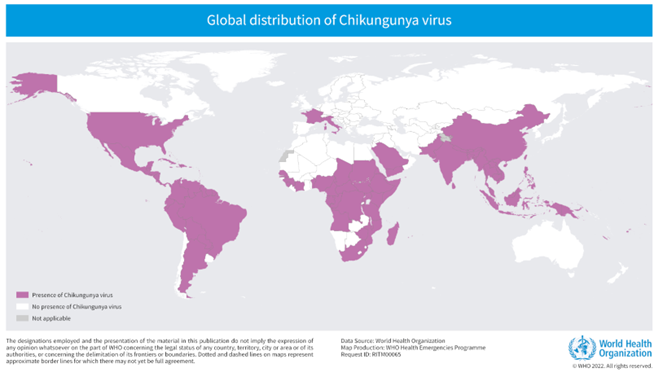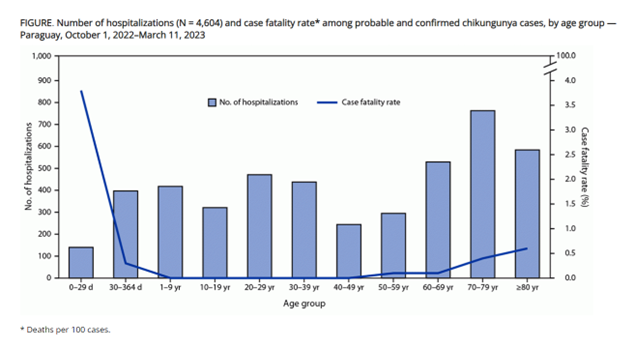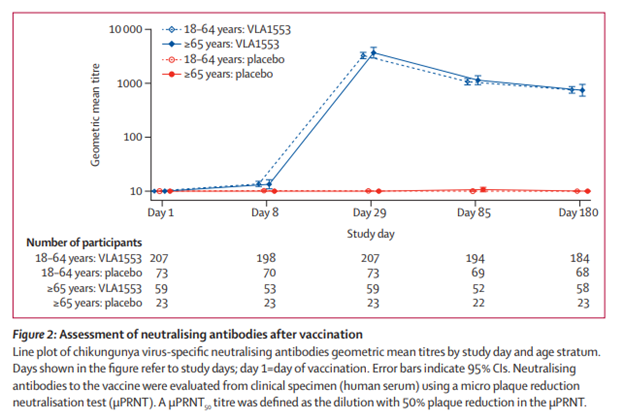As Cases Rise in the Americas, Data from Chikungunya Vaccine Trial Looks Promising
Vaccine Update - July 2023
Column Author: Yvonne M Carter, MSN, APRN, FNP-C | Division of Infectious Diseases, Research
Column Editor: Angela Myers, MD, MPH | Pediatric Infectious Diseases; Division Director, Infectious Diseases; Medical Director, Center for Wellbeing; Professor of Pediatrics, University of Missouri-Kansas City School of Medicine; Clinical Assistant Professor of Pediatrics, University of Kansas School of Medicine
Once confined to the Eastern Hemisphere, outbreaks of chikungunya virus (CHIKV) are now making headlines across the Americas. October 2022 marked the beginning of South America’s worst outbreak since 2013, with Paraguay alone accounting for over a third of cases.1,2 Notorious for causing crippling arthritic pain, CHIKV has no vaccine or treatment yet available. However, recent reports show promising data on a phase 3 trial for a single-injection live-attenuated vaccine candidate, which could not be timelier.3
What is Chikungunya?
CHIKV is a mosquito-borne disease primarily transmitted by Aedes aegypti and Aedes albopictus mosquitoes. Symptoms often begin approximately four to seven days post-infection, with abrupt onset of fever and severe polyarthralgia seen most commonly. Other symptoms may include myalgias, headache, nausea, fatigue or a maculopapular rash. More than 50% of patients infected develop debilitating polyarthralgia or polyarthritis for months or years, mimicking chronic rheumatologic disease. Patients with polyarthralgia and polyarthritis from CHIKV may struggle to walk, move or complete activities of daily living.1,3-5 Studies conducted between 2014 and 2018 showed that CHIKV resulted in a loss of over 150,000 disability-adjusted life-years for Latin Americans in 2014 alone.5
CHIKV was first documented in 1952 during an outbreak in southern Tanzania. The name “chikungunya” comes from the African Makonde language and means “bent over in pain.”2,4 Expansion of mosquito habitats due to climate change and globalization has led to an increase in the geographic ranges of Aedes aegypti and Aedes albopictus, allowing these species of mosquitoes to thrive in regions where they could not previously survive.2-5 CHIKV is now recognized as a global health threat, with over 5 million infections reported from over 100 countries in the past 15 years.3,6 (Figure 1).
Figure 1. Global Distribution of CHIKV as of 2022.

A Timeline of Chikungunya in the Americas
In 2013, the first local CHIKV case in the Americas was detected on the island of St. Martin. An explosive outbreak followed, resulting in over 1 million infections across South America in a matter of months.2,5-7 2014 marked the beginning of local transmission in the U.S., with cases identified in Florida, Texas, Puerto Rico and the U.S. Virgin Islands. In 2015, CHIKV became a nationally notifiable condition in the U.S., and in 2018 it was named a priority pathogen for vaccine development by the World Health Organization.5,7
Presently, Paraguay is experiencing the worst epidemic of CHIKV in the nation’s history, with over 81,037 cases recorded by the Paraguayan Ministry of Health from Oct. 1, 2022 to March 11, 2023. For context, the highest number of Paraguay CHIKV cases prior to 2022 was 5,221 in 2015-2016, after the country’s first autochthonous infection in 2015.1 Countries with no prior record of local transmission, such as Argentina and Uruguay, are reporting locally spread cases for the first time in history as of this year.1,2 The Pan American Health Organization has reported over 214,000 total cases across regions of Latin and South America within the first four months of 2023.2
Snapshot of Paraguay’s Chikungunya Outbreak: Pediatric Cause for Concern
Groups at greatest risk for severe disease or death from CHIKV include infants, elderly adults and those with comorbidities. In Paraguay, although the median age of infection is 36 years, infants are suffering the most. As of March 11, 2023, 208 (0.4%) cases were reported in infants aged < 29 days (neonates). Among these, 140 were hospitalized and eight died, making neonates the age group with the highest case fatality rate (3.8%).1 (Figure 2). Timing of symptom onset among fatal cases indicated that mosquito-borne transmission was likely responsible for only 25% of deaths, with intrapartum transmission likely accounting for the other 75%. The Centers for Disease Control and Prevention notes that because deterioration can occur rapidly, newborns should be monitored closely during the first week of life if intrapartum exposure is suspected.1
Figure 2. Paraguay CHIKV Hospitalizations and Case Fatality Rate by Age: Oct. 1, 2022-March 11, 2023

Vaccine Development
In June 2023, Martina Schneider and colleagues reported results of a phase 3 trial for a live-attenuated CHIKV vaccine, VLA1553. This double-blind, multi-center, randomized trial studied 4,128 healthy adults in the U.S. Participants were randomized to receive vaccine or placebo at a 3:1 ratio and followed up for six months. The study included a subset of 362 participants in a per-protocol population for immunogenicity analysis, with 266 in the VLA1553 group and 96 in the placebo group. After a single vaccination, the immunogenicity analyses showed that VLA1553 induced seroprotective CHIKV neutralizing antibody levels in 98.9% (263 of 266) of participants in the VLA1553 group 28 days post-vaccination, independent of participant age.3 (Figure 3).
Figure 3. Assessment of neutralizing antibodies after vaccination

Data Safety and Monitoring Board review identified no safety concerns and found VLA1553 to be safe and well tolerated overall. The live-attenuated vaccine did elicit fever in 13.9% (427) of the 3,082 participants receiving VLA1553, compared to 1.3% (13 of 1,033) of participants in the placebo group. Arthralgia was also seen in 18% (554) of the 3.082 VLA1553 participants, compared to 6.1% (63 of 1033) of placebo recipients. Even so, severe adverse effects lasting three days or more were low among vaccine recipients (0.3% vs. 0.1% of placebo group).3
The study did not assess safety or immunogenicity in anyone with a history of CHIKV, which could possibly enhance reactogenicity or neutralize the live vaccine. Live-attenuated vaccines are also usually contraindicated in immunocompromised or pregnant persons—two of the most vulnerable populations at risk for severe disease from CHIKV. While this trial excluded children, there is an ongoing study in Brazil evaluating VLA1553 in adolescents.3,5 More studies like this are needed, as research in endemic regions—perhaps even amid an epidemic, although difficult to predict—will further support what VLA1553 offers for prevention of disease caused by CHIKV. Nevertheless, VLA1553 has proven an excellent candidate thus far.
References:
- Torales M, Beeson A, Grau L, et al. Notes from the field: chikungunya outbreak—Paraguay, 2022-2023. MMWR Morb Mortal Wkly Rep. 2023;72:636-638. doi:10.15585/mmwr.mm7223a5
- With rising cases, experts discuss Chikungunya spread in the Americas. Pan American Health Organization. Accessed June 19, 2023. https://www.paho.org/en/news/4-5-2023-rising-cases-experts-discuss-chikungunya-spread-americas
- Schneider M, Nerciso-Abraham M, Hadl S, et al. Safety and immunogenicity of single-shot live-attenuated chikungunya vaccine: a double-blind, multicentre, randomised, placebo-controlled, phase 3 trial. Lancet. 2023;401:2138-2147. doi:10.1016/S0140-6736(23)00641-4
- Chikungunya. Pan American Health Organization. Accessed July 7, 2023. https://www.paho.org/en/topics/chikungunya
- Stephenson KE. Live-attenuated Chikungunya vaccine: a possible new era. Lancet 2023; 401:2090-2091. doi:10.1016/S0140-6736(23)01170-4
- Chikungunya. World Health Organization. Accessed July 12, 2023. https://www.who.int/health-topics/chikungunya
- Chikungunya in the US. Centers for Disease Control and Prevention. Accessed June 19, 2023. https://www.cdc.gov/chikungunya/geo/chikungunya-in-the-us.html
See all the articles in this month's Link Newsletter
Stay up-to-date on the latest developments and innovations in pediatric care – read the July issue of The Link.